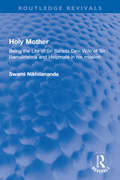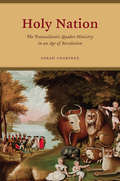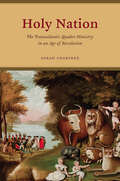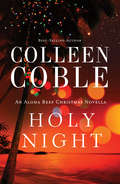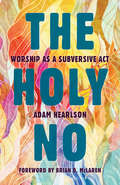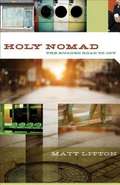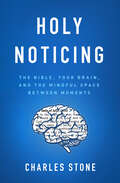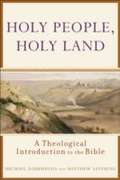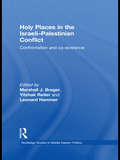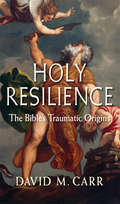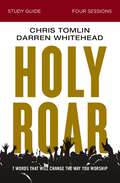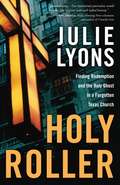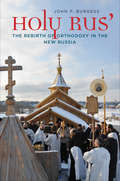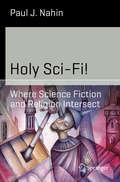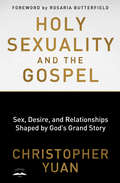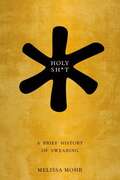- Table View
- List View
Holy Mother: Being the Life of Sri Sarada Devi Wife of Sri Ramakrishna and Helpmate in his mission (Routledge Revivals)
by Swami NikhilanandaFirst Published in 1963, Holy Mother presents the life and teachings of an extraordinary saint of modern India, who lived outwardly the life of an ordinary Hindu woman. Sri Sarada Devi (1853-1920) was brought up in poverty but also in contentment. She gained her sainthood not through unusual austerities, but through regular practice of prayer and meditation, utter devotion in the service of her husband, and discharging her duties towards her demanding worldly-minded relatives. Yet her spiritual experiences were as deep as those of Sri Ramakrishna (1836-1886). Her life was a demonstration of the inner peace that comes from communication with God, even to one who is occupied with the activities of the world. Sri Ramakrishna trained her for her future role as his spiritual successor and through her he demonstrated the Motherhood of God. Her advent acted as a leaven silently raising the newly awakened consciousness of womanhood everywhere. This book is indispensable for scholars and researchers of Hinduism, religion, Indian philosophy, Indian culture, and heritage.
Holy Nation: The Transatlantic Quaker Ministry in an Age of Revolution
by Sarah CrabtreeEarly American Quakers have long been perceived as retiring separatists, but in Holy Nation Sarah Crabtree transforms our historical understanding of the sect by drawing on the sermons, diaries, and correspondence of Quakers themselves. Situating Quakerism within the larger intellectual and religious undercurrents of the Atlantic World, Crabtree shows how Quakers forged a paradoxical sense of their place in the world as militant warriors fighting for peace. She argues that during the turbulent Age of Revolution and Reaction, the Religious Society of Friends forged a "holy nation," a transnational community of like-minded believers committed first and foremost to divine law and to one another. Declaring themselves citizens of their own nation served to underscore the decidedly unholy nature of the nation-state, worldly governments, and profane laws. As a result, campaigns of persecution against the Friends escalated as those in power moved to declare Quakers aliens and traitors to their home countries. Holy Nation convincingly shows that ideals and actions were inseparable for the Society of Friends, yielding an account of Quakerism that is simultaneously a history of the faith and its adherents and a history of its confrontations with the wider world. Ultimately, Crabtree argues, the conflicts experienced between obligations of church and state that Quakers faced can illuminate similar contemporary struggles.
Holy Nation: The Transatlantic Quaker Ministry in an Age of Revolution (American Beginnings, 1500–1900)
by Sarah CrabtreeEarly American Quakers have long been perceived as retiring separatists, but in Holy Nation Sarah Crabtree transforms our historical understanding of the sect by drawing on the sermons, diaries, and correspondence of Quakers themselves. Situating Quakerism within the larger intellectual and religious undercurrents of the Atlantic World, Crabtree shows how Quakers forged a paradoxical sense of their place in the world as militant warriors fighting for peace. She argues that during the turbulent Age of Revolution and Reaction, the Religious Society of Friends forged a “holy nation,” a transnational community of like-minded believers committed first and foremost to divine law and to one another. Declaring themselves citizens of their own nation served to underscore the decidedly unholy nature of the nation-state, worldly governments, and profane laws. As a result, campaigns of persecution against the Friends escalated as those in power moved to declare Quakers aliens and traitors to their home countries.Holy Nation convincingly shows that ideals and actions were inseparable for the Society of Friends, yielding an account of Quakerism that is simultaneously a history of the faith and its adherents and a history of its confrontations with the wider world. Ultimately, Crabtree argues, the conflicts experienced between obligations of church and state that Quakers faced can illuminate similar contemporary struggles.
Holy Night
by Colleen CobleOne sinister phone call has derailed their wedding.Will they let it tear them apart forever?A Christmas wedding on the beach--what could be more perfect? Poinsettias and fragrant pikake blossoms, soft sand and mistletoe, the gentle sound of the surf and the wedding march played on a ukulele. This wedding has been a long time coming, with Bane's trust issues and Leia's worries about her childlike sister, Eva.Now they can hardly wait for the day to arrive. Thrilled to be a bridesmaid, Eva keeps trying on her ruffled dress. The tent is reserved, the caterers paid. Everything is going as planned--until Leia's phone rings and her world skids out of control. A muffled voice informs Leia that Eva's been kidnapped and will be killed unless Leia calls off the wedding without explanation--and no police! If she disobeys instructions and tells Bane, she'll risk her beloved sister's life. But how can she ever handle this without his help? And how can he ever trust her if she lies to him now?Irresistible romance meets thrilling suspense in this holiday update to USA Today best-selling author COLLEEN COBLE's best-selling Aloha Reef series.
Holy Night and Little Star: A Story for Christmas
by Mitali PerkinsA luminous and tender retelling of the Christmas story from National Book Award nominee Mitali Perkins, author of Bare Tree and Little Wind, that is sure to become a cherished holiday favorite for families of faith.Little Star likes her usual spot in the night sky over Bethlehem. Every night, she twinkles above the hills and hopes that nothing will change. But one night, Maker gathers the galaxy! Holy Night is coming, and Maker wants the planets, Moon, and the stars to all take part. As Maker doles out jobs, Little Star holds back, each new role sounding too hard or too scary. But when Maker eventually calls on her to shine, Little Star discovers she is ready and able to welcome the Child and joins the other stars and planets in celebration.Khoa Le&’s shimmering illustrations are the perfect complement to Mitali&’s unique take on the Christmas story. Readers young and old will be captivated by Little Star&’s journey as she discovers that Maker welcomes even the quietest gifts. Parents of faith will appreciate the message about the true gifts of Christmas and the foreshadowing of Jesus&’ mission of salvation, making it a book families can enjoy together year after year.
The Holy No: Worship as a Subversive Act
by Adam HearlsonIn this book Adam Hearlson argues that Christians can say a holy &“no&” to oppression and injustice through the church&’s worship practices. &“To speak the holy no,&” Hearlson says, &“is to refuse to be complicit in the oppression and violence of the ruling power. It is the courageous critique of the present and its claims of immutability.&”Hearlson draws widely from Christian history to uncover ways the church has used its traditional practices—preaching, music, sacrament, and art—to sabotage oppressive structures of the world for the sake of the gospel. He tells the stories of particular subversive strategies both past and present, including radical hospitality, genre bending, coded speech, and apocalyptic visions.Blending history, theory, and practice, The Holy No is both a testament to the courage of Christians who came before and an encouragement to take up their mantle of faithful subversion.
The Holy No: Worship as a Subversive Act
by Brian D. McLaren Adam HearlsonIn this book Adam Hearlson argues that Christians can say a holy “no” to oppression and injustice through the church’s worship practices. “To speak the holy no,” Hearlson says, “is to refuse to be complicit in the oppression and violence of the ruling power. It is the courageous critique of the present and its claims of immutability.”Hearlson draws widely from Christian history to uncover ways the church has used its traditional practices—preaching, music, sacrament, and art—to sabotage oppressive structures of the world for the sake of the gospel. He tells the stories of particular subversive strategies both past and present, including radical hospitality, genre bending, coded speech, and apocalyptic visions.Blending history, theory, and practice, The Holy No is both a testament to the courage of Christians who came before and an encouragement to take up their mantle of faithful subversion.
Holy Nomad: The Rugged Road to Joy
by Matt LittonWe drown ourselves with monotony, possessions, and obligations. However, from Abraham to Jesus, the essence of faith is found in the idea that we are moving, changing, progressing as a people, and if we are faithful to this process, then we will be moving the world toward the Kingdom of God--living a dynamic faith. Holy Nomad is a deeply motivational call for readers to live a radical, relentless, and raw life of faith. Author Matt Litton explains how and why God wants to liberate so we can live a life of absolute freedom and fulfillment. Holy Nomad calls for readers to divest themselves from all the things that hold us back in order to go on this nomadic adventure, that will challenge us and reward us on this rugged road to joy.
Holy Noticing: The Bible, Your Brain, and the Mindful Space Between Moments
by Charles StoneDoes your life ever feel like one series of rushed moments after another?Do you want to feel more present and connected to those you love? Do you want to be able to listen without thinking the whole time of what you&’re going to say next? Do you want to feel less distracted, less busy, and more whole? Most of us spend our distracted lives longing to get to the next, better moment and fail to notice the present one. We lack space between one task and the next, one thought and the next, one email and the next. Social media, TV, work deadlines, and family stress steal our enjoyment and engagement in the moment. Holy Noticing will teach you how to: become more aware of your thoughts, emotions, and environmentrecognize Christ&’s presence in the momentreduce your stress by developing the ability to focus on God and people rather than tasks Many today think mindfulness is dangerous, unchristian, or associated with Eastern religions—and often it is! But Dr. Charles Stone reveals that the art of holy noticing—purposefully paying attention to God as he works in us, our relationships, and our world—is a spiritual discipline Christians have practiced for millennia. Holy Noticing explores the historically Christian and biblical roots of this lifestyle, as well as Dr. Stone&’s BREATHe model, which teaches you to be more engaged with Christ in the everyday moments that too often slip right by us. Discover the lost spiritual discipline of holy noticing today and learn to engage the world like Christ.
Holy Noticing: The Bible, Your Brain, and the Mindful Space Between Moments
by Charles StoneDoes your life ever feel like one series of rushed moments after another?Do you want to feel more present and connected to those you love? Do you want to be able to listen without thinking the whole time of what you&’re going to say next? Do you want to feel less distracted, less busy, and more whole? Most of us spend our distracted lives longing to get to the next, better moment and fail to notice the present one. We lack space between one task and the next, one thought and the next, one email and the next. Social media, TV, work deadlines, and family stress steal our enjoyment and engagement in the moment. Holy Noticing will teach you how to: become more aware of your thoughts, emotions, and environmentrecognize Christ&’s presence in the momentreduce your stress by developing the ability to focus on God and people rather than tasks Many today think mindfulness is dangerous, unchristian, or associated with Eastern religions—and often it is! But Dr. Charles Stone reveals that the art of holy noticing—purposefully paying attention to God as he works in us, our relationships, and our world—is a spiritual discipline Christians have practiced for millennia. Holy Noticing explores the historically Christian and biblical roots of this lifestyle, as well as Dr. Stone&’s BREATHe model, which teaches you to be more engaged with Christ in the everyday moments that too often slip right by us. Discover the lost spiritual discipline of holy noticing today and learn to engage the world like Christ.
Holy Paws: How My Dog Helped Me Heal From Abuse
by Jeannine C. FoxAutobiography of a victim of childhood sexual abuse who used her dog and her belief and trust in God to heal
Holy People, Holy Land: A Theological Introduction to the Bible
by Michael Dauphinais Matthew LeveringThe Bible doesn't come with a secret decoder ring, which means that it is left to church theologians to make sense of the Bible's many intricate and overlapping themes. Over the centuries, the church has identified several themes--such as love and covenant--that have helped the faithful to better understand a sometimes bewildering book. <P> In Holy People, Holy Land, authors Dauphinais and Levering make the case that holiness--which they define as communion with God through love of neighbor--is the central theme of Scripture. Holy People, Holy Land will give any reader the tools to better understand Scripture by showing how a holy God desires to recreate his children in his image so that they too can be holy.
Holy People, Holy Lives: Law and Gospel in Bioethics
by Richard C. EyerThis book highlights the issues of technology and ethics in medical decision-making, seeing God's story, revealed in Law and Gospel, as the foundation for Christian living.
Holy Places in the Israeli-Palestinian Conflict: Confrontation and Co-existence (Routledge Studies in Middle Eastern Politics)
by Marshall J. Breger Yitzhak Reiter Leonard HammerThis book addresses the major generators of conflict and toleration at shared holy places in Palestine and Israel. Examining the religious, political and legal issues, the authors show how the holy sites have been a focus of both conflict and cooperation between different communities. Bringing together the views of a diverse group of experts on the region, Holy Places in the Israeli-Palestinian Conflict provides a new and multifaceted approach to holy places, giving an in-depth analysis of relevant issues. Themes covered include legal regulation of holy places; nationalization and reproduction of holy space; sharing and contesting holy places; identity politics; and popular legends of holy sites. Chapters cover in detail how recognition and authorization of a new site come about; the influence of religious belief versus political ideology on the designation of holy places; the centrality of such areas to the surrounding political developments; and how historical background and culture affect the perception of a holy site and relations between conflicting groups. This new approach to the study of holy places and the Israeli-Palestinian conflict has great significance for a variety of disciplines, and will be of great interest in the fields of law, politics, religious studies, anthropology and sociology.
The Holy Reich
by Richard Steigmann-GallAnalyzing the previously unexplored religious views of the Nazi elite, Richard Steigmann-Gall argues against the consensus that Nazism as a whole was either unrelated to Christianity or actively opposed to it. He demonstrates that many participants in the Nazi movement believed that the contours of their ideology were based on a Christian understanding of Germany's ills and their cure. A program usually regarded as secular in inspiration - the creation of a racialist 'people's community' embracing antisemitism, antiliberalism and anti-Marxism - was, for these Nazis, conceived in explicitly Christian terms. His examination centers on the concept of 'positive Christianity,' a religion espoused by many members of the party leadership. He also explores the struggle the 'positive Christians' waged with the party's paganists - those who rejected Christianity in toto as foreign and corrupting - and demonstrates that this was not just a conflict over religion, but over the very meaning of Nazi ideology itself.
Holy Resilience
by David M. CarrHuman trauma gave birth to the Bible, suggests eminent religious scholar David Carr. The Bible’s ability to speak to suffering is a major reason why the sacred texts of Judaism and Christianity have retained their relevance for thousands of years. In his fascinating and provocative reinterpretation of the Bible’s origins, the author tells the story of how the Jewish people and Christian community had to adapt to survive multiple catastrophes and how their holy scriptures both reflected and reinforced each religion’s resilient nature. Carr’s thought-provoking analysis demonstrates how many of the central tenets of biblical religion, including monotheism and the idea of suffering as God’s retribution, are factors that provided Judaism and Christianity with the strength and flexibility to endure in the face of disaster. In addition, the author explains how the Jewish Bible was deeply shaped by the Jewish exile in Babylon, an event that it rarely describes, and how the Christian Bible was likewise shaped by the unspeakable shame of having a crucified savior.
Holy Roar: 7 Words That Will Change The Way You Worship
by Chris Tomlin Darren WhiteheadWhat happens when we praise God? What are the benefits of praising Him? Do you know what praise actually means? In Holy Roar, Chris Tomlin and Darren Whitehead share a fresh perspective from the worship practices of the ancient world. They take readers on a praise journey that answers questions and provides valuable insight. After reading Holy Roar, you will:Grow an understanding of praise with Darren's unique insights.Gain a deeper understanding of how to worship.Be inspired as Chris shares how those insights take shape in the stories behind some of your favorite worship songs, including "How Great Is Our God," "We Fall Down," and "Good Good Father."Holy Roar is for:Readers of all ages interested in growing their faithPastors, worship leaders, and small group teachers leading believersIn the ancient world, something extraordinary happened when God's people gathered to worship Him. It was more than just singing; it was a declaration, a proclamation, a time to fully embody praise to God for who He is and what He has done. In fact, in the Psalms, seven Hebrew words are translated into the English word praise, each of which represents a different aspect of what it means to truly praise God.
Holy Roar Study Guide: Seven Words That Will Change the Way You Worship
by Chris Tomlin Darren Whitehead Bethany O. GraybillIn this four-session video Bible study (DVD/digital downloads sold separately), Chris Tomlin and Darren Whitehead share a fresh perspective from the worship practices of the ancient world to show what it really means to praise God. They explain that in the Jewish culture, something extraordinary happened when God's people gathered to worship him. It was more than just singing—it was a declaration, a proclamation, and a time for the people to fully embody praise to God for who he is and what he has done.In the book of Psalms, the writers used seven distinct words that are translated into English as praise. However, as Chris and Darren point out in this study, each of these Hebrew words actually represents a different aspect of what it means to truly worship God:Yadah: to revere or worship with extended handsHalal: to boast, celebrate, and be clamorously foolishZamar: to celebrate in song and in musicTowdah: to give thanksgiving for things not yet receivedBarak: to kneel before God and bless himTehillah: to sing a spontaneous song to GodShabach: to commend, glory, and triumphHoly Roar will provide insights and encouragement for group members to deepen their practice of praise and they learn about the deeper meanings of these words and put them into practice.Sessions include:The Shout of PraiseThe Posture of PraiseThe Music of PraiseThe Expectation of Praise Designed for use with the Holy Roar Video Study (sold separately).
Holy Roller: Finding Redemption and the Holy Ghost in a Forgotten Texas Church
by Julie LyonsJulie Lyons was working as a crime reporter when she followed a hunch into the South Dallas ghetto. She wasn’t hunting drug dealers, but drug addicts who had been supernaturally healed of their addictions. Was there a church in the most violent part of the city that prayed for addicts and got results? At The Body of Christ Assembly, a rundown church on an out-of-the-way street, Lyons found the story she was looking for. The minister welcomed criminals, prostitutes, and street people–anyone who needed God. He prayed for the sick, the addicted, and the demon-possessed, and people were supernaturally healed. Lyons’s story landed on the front page of theDallas Times Herald. But she got much more than just a great story, she found an unlikely spiritual home. Though the parishioners at The Body of Christ Assembly are black and Pentecostal, and Lyons is white and from a traditional church background, she embraced their spirituality–that of “the Holy Ghost and fire. ” It’s all here inHoly Roller–the stories of people desperate for God’s help. And the actions of a God who doesn’t forget the people who need His power. From the Hardcover edition.
Holy Rus': The Rebirth of Orthodoxy in the New Russia
by John P. BurgessA fascinating, vivid, and on-the-ground account of Russian Orthodoxy's resurgence A bold experiment is taking place in Russia. After a century of being scarred by militant, atheistic communism, the Orthodox Church has become Russia's largest and most significant nongovernmental organization. As it has returned to life, it has pursued a vision of reclaiming Holy Rus': that historical yet mythical homeland of the eastern Slavic peoples; a foretaste of the perfect justice, peace, harmony, and beauty for which religious believers long; and the glimpse of heaven on earth that persuaded Prince Vladimir to accept Orthodox baptism in Crimea in A. D. 988. Through groundbreaking initiatives in religious education, social ministry, historical commemoration, and parish life, the Orthodox Church is seeking to shape a new, post-communist national identity for Russia. In this eye-opening and evocative book, John Burgess examines Russian Orthodoxy's resurgence from a grassroots level, providing Western readers with an enlightening, inside look at the new Russia.
Holy Sci-Fi!
by Paul J. NahinCan a computer have a soul? Are religion and science mutually exclusive? Is there really such a thing as free will? If you could time travel to visit Jesus, would you (and should you)? For hundreds of years, philosophers, scientists and science fiction writers have pondered these questions and many more. In Holy Sci-Fi!, popular writer Paul Nahin explores the fertile and sometimes uneasy relationship between science fiction and religion. With a scope spanning the history of religion, philosophy and literature, Nahin follows religious themes in science fiction from Feynman to Foucault and from Asimov to Aristotle. An intriguing journey through popular and well-loved books and stories, Holy Sci-Fi! shows how sci-fi has informed humanity's attitudes towards our faiths, our future and ourselves.
Holy Scripture
by John WebsterMay we speak, in the present age, of holy scripture? And what validation of that claim can be offered, robust enough to hold good for both religious practice and intellectual enquiry? John Webster argues that while any understanding of scripture must subject it to proper textual and historical interrogation, it is necessary at the same time to acknowledge the special character of scriptural writing. His 2003 book is an exercise in Christian dogmatics, a loud reaffirmation of the triune God at the heart of a scripture-based Christianity. But it is written with intellectual rigour by a theologian who understands the currents of modern secular thought and is able to work from them towards a constructive position on biblical authority. It will resonate with anyone who has wondered or worried about the grounds on which we may validly regard the Bible as God's direct communication with humanity.
Holy Sex!
by Gregory K. PopcakCommon wisdom portrays sex and church to be at odds, yet studies show that Catholics have better sex, and more often. This witty, frank, and refreshingly orthodox book draws from the beautiful truths of Catholic teaching to show people of all faiths about rich and satisfying sexuality. Hailed by Christians across the spectrum from Christopher West and Janet E. Smith to John L. Allen, Jr. ,Holy Sex!includes dozens of questionnaires, quizzes, and valuable lessons from real-life stories.
Holy Sexuality and the Gospel: Sex, Desire, and Relationships Shaped by God's Grand Story
by Christopher Yuan Rosaria ButterfieldFrom the author of Out of a Far Country, which details his dramatic conversion from an agnostic gay man who put his identity in his sexuality to a Bible professor who now puts his identity in Christ alone, comes a gospel-centered discussion of sex, desire, and relationships.Dr. Christopher Yuan explores the concept of holy sexuality--chastity in singleness or faithfulness in marriage--in a practical and relevant manner, equipping readers with an accessible yet robust theology of sexuality. Whether you want to share Christ with a loved one who identifies as gay or you're wrestling with questions of identity yourself, this book will help you better understand sexuality in light of God's grand story and realize that holy sexuality is actually good news for all.
Holy Sh*t: A Brief History of Swearing
by Melissa MohrDetermining what is obscene is a timeless preoccupation, nearly as timeless as the search for words that adequately express a relationship with the divine. As Melissa Mohr shows in this imaginative and illuminating tour through linguistic history, those preoccupations are not separate. "Swearing" is what we do when we forge a bond with a higher authority, as when we tell the truth and nothing but the truth; it is also what we do to break that bond. In both cases, certain words are endowed with the power to shock or to awe. Obscenities tend toward the earthy and generally remind us that we have bodies. Oaths are lifted to heaven and serve to remind us that we have souls. Holy Sh*t brilliantly and entertainingly investigates these two kinds of swearing--obscenities and oaths--from ancient Rome and the Bible to the present, uncovering the history of sacred and profane language in English through the ages. It is a journey with a number of surprises. Obscenities in ancient Rome were remarkably similar to our own; George Carlin would have felt completely at home. With the rise of the Church came a new sense of how language should be used, or not--and the difference was often a matter of life and death. Holy Sh*t tracks the advancement of civility and corresponding censorship of language in the eighteenth century; considers the rise of racial slurs after World War II; examines the physiological effects of swearing (increased heart rate and greater pain tolerance); and answers a question that preoccupies the FCC, the U.S. Senate, and anyone who has lately visited a junior high school: are we swearing more now than people did in the past? A gem of lexicography and cultural history, Holy Sh*t is a serious exploration of linguistic totem and taboo. It charts the way swearing has changed over the centuries, and considers the cultural concerns that gave way to those changes. By looking at the words that have expressed our deepest emotions, high and low, Holy Sh*t reveals the shifting relationship between the divine and the dirty. MELISSA MOHR has recently been dividing her time between writing this book about swearing, and hiding it from her kids. She received a Ph.D. in English literature from Stanford University, specializing in Medieval and Renaissance literature. She lives in Somerville, Massachusetts.
